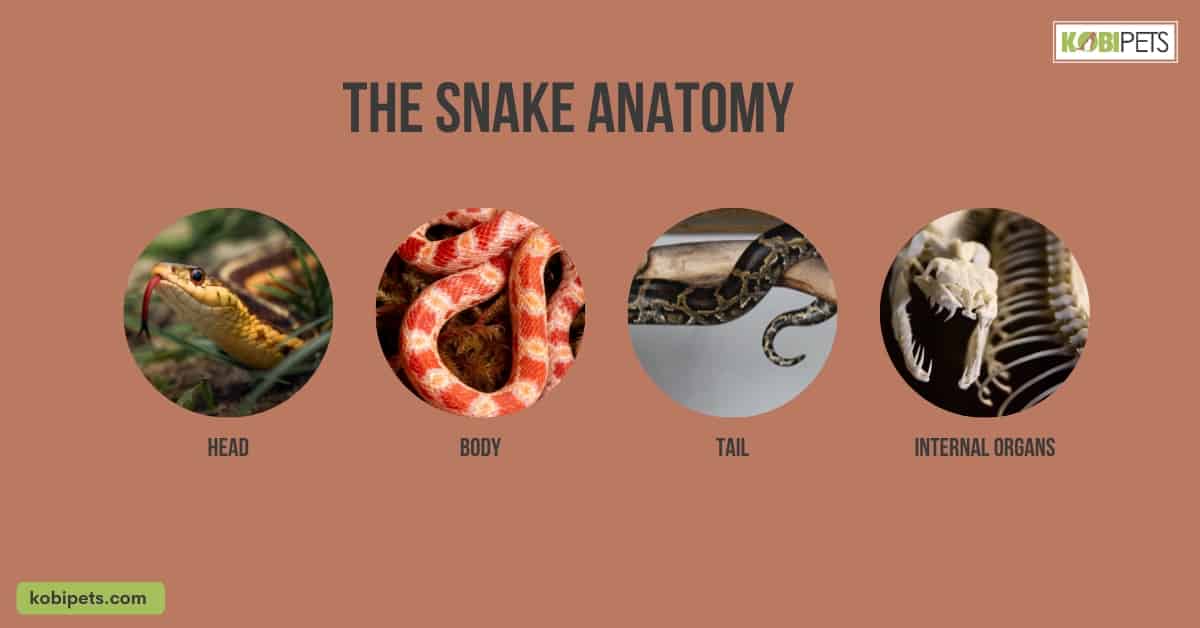
Determining the sex of a snake can be done by observing the shape and size of its cloacal opening or by probing. In experienced hands, probing is the most accurate method, although it should only be done by a veterinarian or experienced reptile keeper.
Knowing the sex of a snake can help you provide the best possible environment for your reptilian friend and prevent any unwanted surprises! This article will provide information on how to determine the sex of your pet snake.
The Snake Anatomy
Snakes are fascinating creatures that come in various shapes and sizes. They have a unique anatomy that has evolved over millions of years to help them move, hunt, and survive in their environment.
Understanding the anatomy of a snake can provide insight into its behavior and how they interact with its environment.

The Snake Anatomy
Head
The head of a snake is distinct and separate from its body, allowing for greater flexibility and mobility when hunting or navigating difficult terrain. Snakes have two specialized sensory organs.
The Jacobson’s organ is in the roof of their mouth, and the pit organ is located between their eyes, which they use to detect prey and predators. They also have fangs that are used to inject venom into their prey or to defend themselves.
Body
The body of a snake is long, flexible, and covered in scales that provide protection and help regulate body temperature. Snakes do not have legs, but their long, muscular bodies allow them to move easily through their environment.
The spine of a snake is composed of numerous vertebrae which give it its flexibility, and its muscles are arranged in such a way that they can generate powerful contractions for movement.
Tail
The tail of a snake is used for balance and stability when moving, and also serves as a tool to distract and lure prey. Some species of snakes also have spiny or knobbed tails that can be used for defense against predators.
Internal organs
Like all vertebrates, snakes have a complete digestive and respiratory system. Their heart is located near the head and pumps blood to the rest of the body. Snakes have a unique respiratory system that allows them to breathe while swallowing their prey.
Their kidneys are also highly specialized, allowing them to conserve water in their arid environments.
Snakes have a complex and fascinating anatomy that has evolved to help them survive in their environment. Understanding the structure and function of their various body parts can provide insight into their behavior and way of life.

Common Physical Differences Between Male and Female Snakes
Snakes come in an incredible array of shapes, sizes, and colors. In addition to these varieties, there are a variety of ways that male and female snakes differ physically. While most differences may be subtle, they can be important in determining the identity of a snake. This article explores some of the more common physiological differences between male and female snakes.
| Male | Female |
|---|---|
| Male snakes tend to have longer tails than females which helps them detect pheromones as part of their mating rituals. | Females typically have shorter tails than males, enabling them to store nutrients for reproduction, egg production, and development following mating. |
| Males generally have thicker necks than females as part of their reproductive system, facilitating the insertion of hemipenes during copulation. | Females typically have wider bodies when compared to males to accommodate egg growth prior to laying eggs or giving birth to live young. |
| Some male snakes display small spurs on either side near the cloaca which is used during courtship activities with potential mates. | Females typically display larger scales around the cloacal area which can be used by males for better grip during mating rituals. |
| Male snakes often display a brighter color pattern when compared with females in order to attract mates or ward off predators or competitors. This is particularly true for cobra species such as king cobras or spitting cobras which boast bright colors like yellow and red-orange that both males and females share but with more vibrancy from males than from females. | Female snakes typically present duller colors than their male counterparts due to decreased need for communicating with potential mates or scaring away threats. |

Steps On Finding Out The Sex Through Probing or “Poking” the Anus
Determining the sex of a snake through probing or “poking” the anus is a common method used by many snake owners and breeders. While this can be a relatively simple process, it requires some practice and skill to accurately identify a snake’s sex. Here are the steps you need to take to properly perform this procedure.
Step One: Gently Position Your Snake
The first step of this process is to carefully hold your snake so that you may access its cloaca – the hole at the base of its tail where waste and reproductive organs are expelled. You mustn’t squeeze too hard or put excessive pressure on your snake as this can cause them discomfort or pain.
Step Two: Insert Your Tool into Cloaca and Probe Around
Once your snake is securely held, you will want to insert a small object such as a toothpick into its cloaca and gently probe around inside. If your snake is male, two distinct bumps should be present which correspond to hemipenes – structures used for reproduction during copulation.
Step Three: Identify Bumps or Skin Folds
If there do not appear to be any bumps when you probe with your tool, then your snake will likely belong to the female sex; in contrast to males who possess two hemipenes, female snakes usually only have one large scale covering their entire cloacal region and skin folds surrounding the area may also be visible if inspected closely enough.
By following these steps, you should now have an accurate idea of whether your snake belongs to the male or female sex after probing its anus. However, external characteristics such as size, head shape, or coloration may also vary between sexes depending on the species. It is important not to rely solely on probing but rather uses multiple methods to ensure the accuracy of results.

Tips on How to Tell the Difference between a Male and Female Snake with Visual Cues
Many snake owners or breeders might be curious about the sex of their pet or breeding snakes but cannot find someone with the knowledge or tools necessary to accurately determine its sex.
Luckily, there are a variety of visual cues that can be used to tell the difference between male and female snakes. Here is a handy table outlining some tips you can use:
Cloacal Shape: The cloaca is the opening at the base of the tail where the reproductive, digestive, and urinary tracts exit. In males, the cloaca is typically more elongated and pointed, while in females it is wider and rounder.
Hemipenes: Male snakes have two hemipenes, which are retractable sex organs located near the base of the tail. In some species, the presence of bulges near the base of the tail can indicate the presence of hemipenes.
Body Size: In some species, males tend to be larger than females. However, this is not always the case, and size alone cannot be used to determine the sex of a snake.
Tail Length: In some species, males have longer tails than females, although this can vary depending on the species and age of the snake.
It is important to note that these visual cues can be subtle and can vary greatly between species, so it is best to seek the advice of a veterinarian or experienced reptile keeper if you need to determine the sex of a snake.
When determining a snake’s sex, it is important not to rely solely on visual cues as many external characteristics can vary between sexes depending on the species. While visual cues will give us some indication of a snake’s sex, additional methods such as probing or DNA testing should also be employed for accurate results.

In conclusion
Determining the sex of a snake can be an intimidating task. However, with practice and the proper tools, it can be done. By examining visual cues such as cloacal shape, hemipenes, body size, and tail length, you may be able to identify your snake’s gender.
For more accurate results, probing or DNA testing may be necessary. With these helpful tips, you should now have the knowledge and confidence to properly identify your pet snake’s sex!






